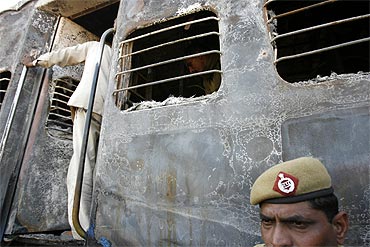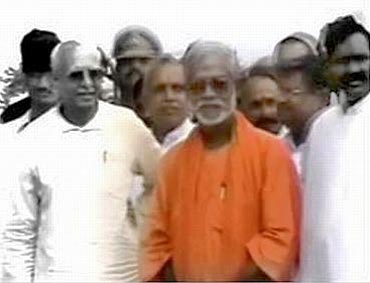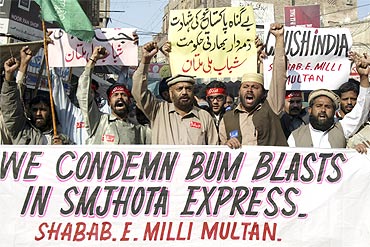This article was first published 14 years ago
Home »
News » Samjhauta blasts: A tale of two confessions
Samjhauta blasts: A tale of two confessions
Last updated on: January 13, 2011 14:15 IST
Image: A policeman stands outside a burnt carriage of a Samjhauta Express train
Photographs: Desmond Boylan/Reuters
While the National Investigation Agency is focusing on the confessions made by Swami Aseemanand about the involvement of Hindu extremist groups in the Samjhauta Express blasts case, the revelations by Students Islamic Movement of India claiming responsibility for the attack cannot be overlooked. The contradictory statements by the two radical groups have left the investigators going in circles, reports Vicky Nanjappa.
October 2008: The Samjhauta blasts were carried out with the help of activists of SIMI with the help of Pakistani nationals who had come to the country from across the border.
-- Safdar Nagori, chief of the SIMI Nagori faction.
January 2011: On February 16, 2007 I met Sunil Joshi and Bharat Rateshwar at Balpur and I was told that there was some good news in store for me. I then returned to Shabri Dam, my ashram in the Dangs region of Gujarat, and two days later read about the Samjhauta blasts in the newspaper. I confronted Joshi and he said that his men had carried out the blasts.
-- Swami Aseemanand in his confession statement before a Delhi court.
These two confessions coming from two radicals belonging to opposite factions makes the case of the Samjhauta Express blasts that claimed 68 lives even murkier.
...
Also read:
Samjhauta blasts: Aseemanand NOT the mastermind
Aseemanand's confession talks of planning 4 blasts
Meet the youth who inspired Aseemanand to confess
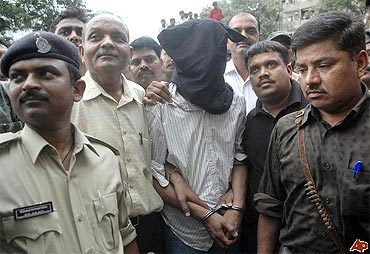
Image: Safdar Nagori in police custody
Safdar Nagori, who had broken away from mainstream SIMI since he wanted the faction to become more aggressive following the ban on the organisation, was arrested by the Madhya Pradesh police two years back.
He was subjected to thorough interrogation and also underwent a narco-analysis test in which the police claim he spoke about the Samjhauta blasts as well as the 7/11 Mumbai train bombings.
During his interrogation, Nagori made some startling revelations about how these deadly attacks were executed. He told investigators that the blasts were carried out by SIMI activists with the help of some Pakistani nationals. The motive of the attack was to derail the Indo-Pak peace talks by targetting the train connecting Delhi and Lahore.
Of the 68 passengers who lost their lives in the blast most were Pakistani civilians.
Image: Swami Aseemanand
Aseemanand on the other hand who was arrested on November 19 for his involvement in the blasts in a confessional statement before a metropolitan magistrate of Tis Hazari court in New Delhi said that while he was aware of the blast, he had no direct role to play.
The swami maintained that the blast was planned by Joshi, his alleged right-hand man, who was murdered in mysterious circumstances in Dewas in Madhya Pradesh on December 29, 2007. However, Aseemanand's confessions have now opened a can of worms, which have left both the police and National Investigation Agency probing this case scratching their heads.
Image: Pakistanis chant anti-India slogans in Multan
Photographs: Asim Tanveer/Reuters
It was only a year back that the name of Aseemanand cropped up in the case, prior to which investigators believed that the Pakistan-based terror group Lashkar-e-Tayiba supported the SIMI to carry out the attack.
This poses another question before investigators. Which of the two reports should be produced before the court? Legal experts say the cases showing involvement of both the outfits should be presented before the law. The fact that Aseemanand's confession is recent does not mean that Nagori's revelations hold no water.
The NIA is far from cracking the case. In fact, since both the confessions are contrary they have a tough task ahead of them to build up a case and will now need to probe even harder.
Justice N Satosh Hegde, former judge of the Supreme Court of India, explains that a lot would depend on the judge presiding over the case. Though it appears that Aseemanand's confession holds more weightage, it may be an uphill task for the NIA if he retracts his statement saying that he had done so under duress. Nagori's claims, though cannot be completely overlooked, hold less weightage since they were made before the police. Moreover, the narco-analysis test does not hold much value as the Supreme Court earlier this year declared its use as illegal if it has been conducted without the consent of the suspect.
However, legal experts believe that even Aseemanand's statements will have little impact on the case, as they are not sufficient to guarantee a conviction. The most such a confession can do is give supportive evidentiary value to the investigating agency.
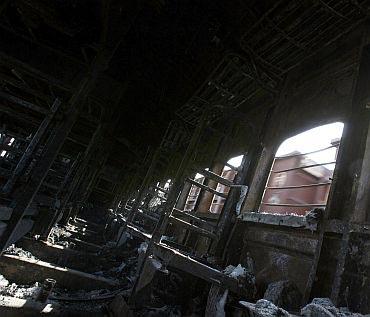
Image: File photo of the charred Samjhauta Express compartment
Photographs: Reuters
The court will have to look into other evidence supplied by the investigating agency to finally come to a conclusion in the case. A lot will however depend on what the two accused -- Nagori and Aseemanand -- finally say before the court.
Currently, the NIA is completely focused on the Aseemanand angle and feel that there is more meat in this version. However, they need to gather more proof and hence it is crucial that they take into custody Sandeep Dange, Ramji Kalsangre and Ashok who goes by the alias Amit, the three suspects named by the swami in his confession. According to him, the trio allegedly executed the Samjhauta Express blasts under the guidance of Joshi.
However, investigations cannot be merely on the basis of, a source in the investigating agency said.
